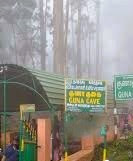Exploring the Enigmatic Guna Caves in Kodaikanal: A Hidden Gem Amidst Nature's Bounty
Kodaikanal,
often referred to as the "Princess of Hill Stations," is a treasure
trove of natural wonders. Nestled within its serene landscapes lies a
fascinating and mysterious site known as Guna Caves. This article delves deep
into everything you need to know about this intriguing destination, offering
insights into its history, natural beauty, and tips for visitors.
1.
Introduction to Guna Caves
2.
The Historical Significance of the Caves
While
Guna Caves became famous due to the movie, its history goes back much further.
Originally known as Devil’s Kitchen, the caves were formed by natural processes
over millions of years. They are situated within the mighty Pillar Rocks area,
a geological marvel in itself. The caves have long been a subject of intrigue
due to their deep crevices and unique rock formations.
3.
The Natural Beauty Surrounding the Caves
The
area around Guna Caves is a haven for nature lovers. Towering pine trees, lush
green valleys, and mist-covered hills create a breathtaking setting. As you
approach the caves, you’ll notice the eerie charm of the place, heightened by
the frequent fog that envelops the landscape. The Pillar Rocks, visible from
the vicinity, add to the dramatic appeal of the region.
4.
What Makes Guna Caves Unique?

The
caves are unique due to their narrow crevices, which make them both fascinating
and dangerous. These crevices are said to be over 30 feet deep, and their sheer
drop-offs have earned them a reputation as a perilous yet awe-inspiring
location. For safety reasons, visitors are not allowed to venture deep into the
caves, but the surrounding viewpoints offer equally mesmerizing experiences.
5.
Flora and Fauna in the Area
The
dense forests surrounding Guna Caves are home to a variety of flora and fauna.
If you’re lucky, you might spot native species like Nilgiris langurs, Indian
giant squirrels, and various birds. The region is also rich in plant life, with
medicinal herbs and vibrant flowers dotting the landscape.
6.
The Mystical Aura of Devil’s Kitchen
Locals
often associate Guna Caves with myths and legends, adding a mystical element to
its allure. The name “Devil’s Kitchen” stems from folklore, with stories of
spirits and supernatural occurrences tied to the caves. Whether you believe in
these tales or not, the atmosphere of the place is undeniably otherworldly.
7.
How to Reach Guna Caves
Guna
Caves are located around 8 kilometers from Kodaikanal’s main town. You can hire
a taxi or take a private vehicle to reach the site. The route is scenic, with
winding roads and panoramic views. From the parking area, a short trek through
a forested trail leads you to the caves.
8.
Best Time to Visit
The
ideal time to visit Guna Caves is during the winter months, from October to
March, when the weather is pleasant and the mist adds to the beauty of the
surroundings. Avoid visiting during the monsoon season as the trails can become
slippery and the visibility may be reduced.
9.
Tips for Visitors
- Wear comfortable trekking shoes for
the forest trail.
- Avoid venturing too close to the
edges of the crevices for safety reasons.
- Keep the environment clean by not
littering.
- Carry a camera or smartphone to
capture the mesmerizing views but be cautious near the cliffs.
- Hire a local guide if you want to
learn more about the history and significance of the place.
10.
Nearby Attractions
While
visiting Guna Caves, you can also explore other nearby attractions in
Kodaikanal:
- Pillar Rocks:
These three massive rocks stand tall and are a must-visit spot for their
stunning views.
- Bryant Park:
A well-maintained botanical garden, perfect for a leisurely stroll.
- Coaker’s Walk:
A picturesque walking trail offering panoramic views of the valley.
- Silver Cascade Falls:
A beautiful waterfall located en route to Kodaikanal.
Conclusion
Guna
Caves in Kodaikanal is more than just a tourist spot; it’s a place where
nature, history, and mystery come together. Whether you’re a traveler seeking
adventure, a nature enthusiast, or simply someone looking to escape the
mundane, the caves offer an unforgettable experience. Remember to respect the
environment and prioritize safety while enjoying the charm of this hidden gem.
"This Content Sponsored by Buymote Shopping app
BuyMote E-Shopping Application is One of the Online Shopping App
Now Available on Play Store & App Store (Buymote E-Shopping)
Click Below Link and Install Application: https://buymote.shop/links/0f5993744a9213079a6b53e8
Sponsor Content: #buymote #buymoteeshopping #buymoteonline #buymoteshopping #buymoteapplication"






Comments
Post a Comment